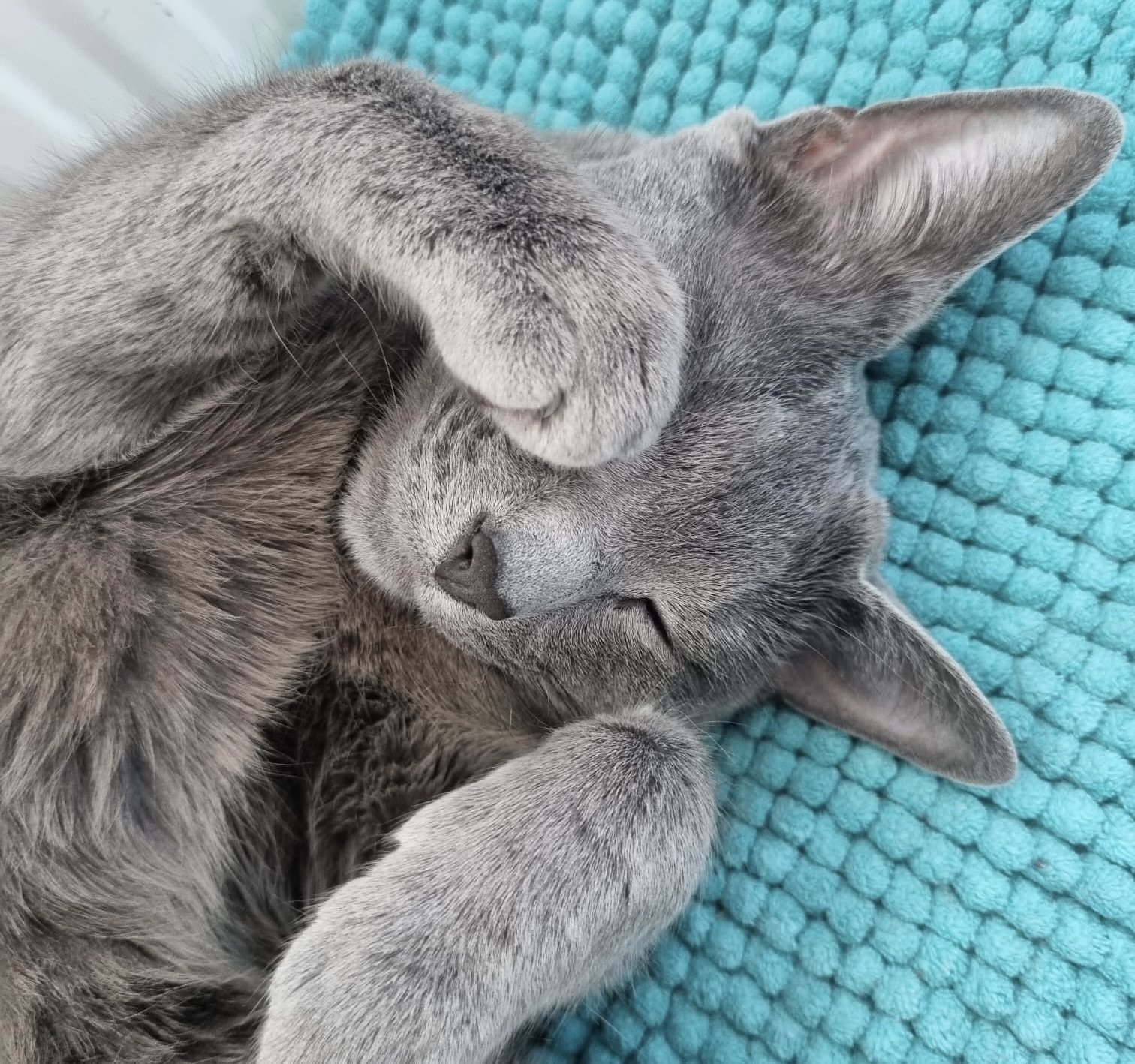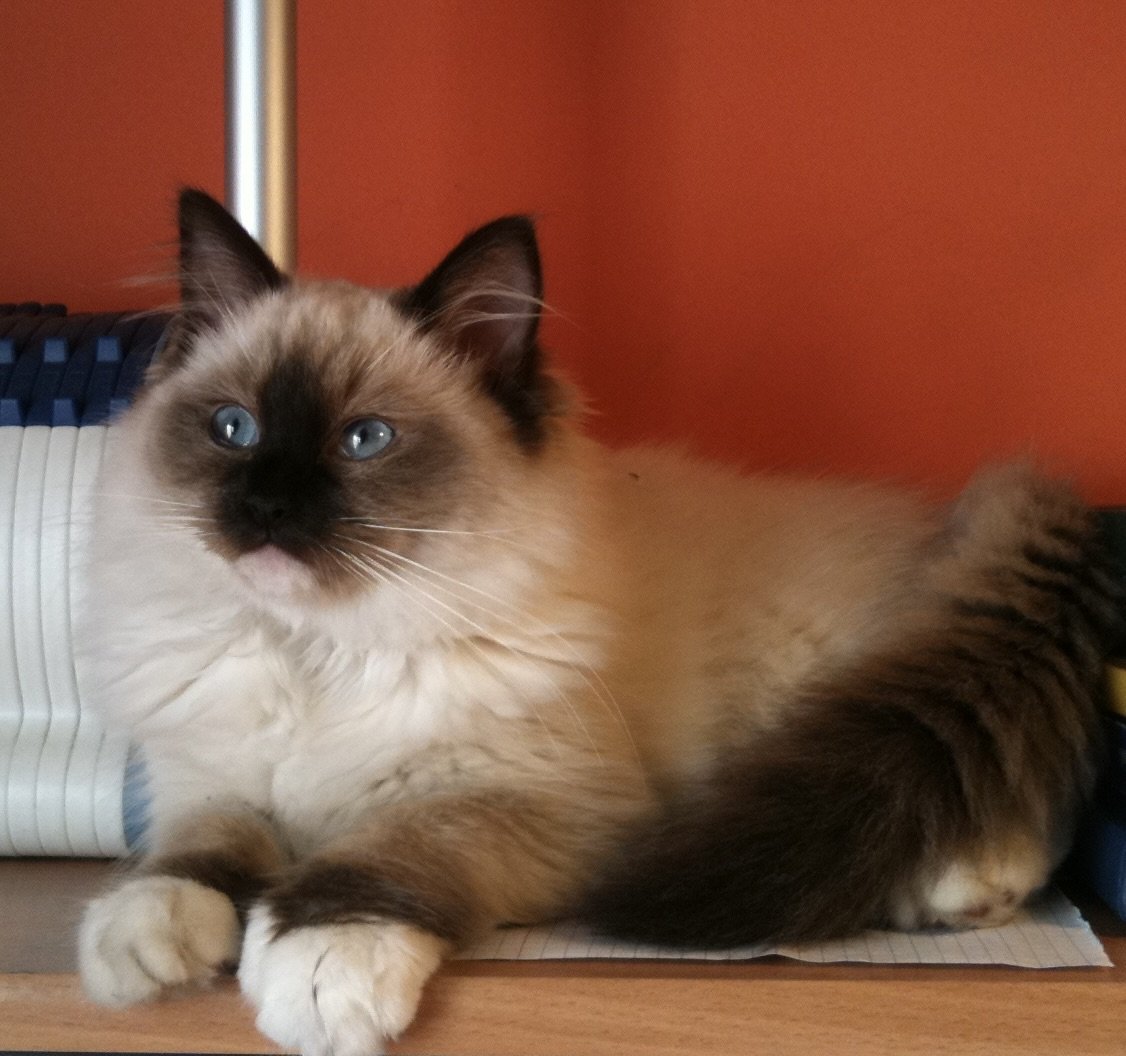
Filters
CLEAR ALLRagdoll cats are large, semi-long haired cats with gorgeous blue eyes. They are described as affectionate and loving cat breeds as they get along well with children, dogs, and other pets. This strong and confident cat breed can blend effortlessly into the eventful contemporary household.
Ragdolls can be seen as a relaxed and happy cat. They often go limp in your arms when held and flop like a stuffed doll when snuggled. Usually, a Ragdoll cat has a laidback disposition. They are loving, calm and docile. They are not talkative either, but they have their playful moments. Ragdoll kittens and young adults are particularly high-spirited.
The sweet-looking Ragdoll cats are the second most popular cat breed registered with the Governing Council of the Cat Fancy (GCCF). It ranks even higher with owners. For many, Ragdoll cats have it all – big expressive blue eyes, a sweet face, silky coat, and heart-melting soul. In return for their loyalty, the only thing the Ragdoll asks is to be part of your world.
Ragdolls enjoy being around people. They have a unique 'smiley' expression that cat lovers adore. This cat breed is known to be easy going and affectionate. The more love and attention you give, you will receive it back and more. They are also tolerant of other animals and children. They are often compared to dogs because of their friendliness and intelligence. They can also be trained to play fetch.
Ragdoll cats are relative newcomers to the cat world. But thanks to their sweet and kind demeanour and charming looks, they are fast becoming one of the most popular cat breeds worldwide. They are large-sized cats that have semi-long hair and beautiful blue eyes.
Ragdoll cats are large, semi-long haired cats with gorgeous blue eyes. They are described as affectionate and loving cat breeds as they get along well with children, dogs, and other pets. This strong and confident cat breed can blend effortlessly into the eventful contemporary household.
Ragdolls can be seen as a relaxed and happy cat. They often go limp in your arms when held and flop like a stuffed doll when snuggled. Usually, a Ragdoll cat has a laidback disposition. They are loving, calm and docile. They are not talkative either, but they have their playful moments. Ragdoll kittens and young adults are particularly high-spirited.
The sweet-looking Ragdoll cats are the second most popular cat breed registered with the Governing Council of the Cat Fancy (GCCF). It ranks even higher with owners. For many, Ragdoll cats have it all – big expressive blue eyes, a sweet face, silky coat, and heart-melting soul. In return for their loyalty, the only thing the Ragdoll asks is to be part of your world.
Ragdolls enjoy being around people. They have a unique 'smiley' expression that cat lovers adore. This cat breed is known to be easy going and affectionate. The more love and attention you give, you will receive it back and more. They are also tolerant of other animals and children. They are often compared to dogs because of their friendliness and intelligence. They can also be trained to play fetch.
Ragdoll cats are relative newcomers to the cat world. But thanks to their sweet and kind demeanour and charming looks, they are fast becoming one of the most popular cat breeds worldwide. They are large-sized cats that have semi-long hair and beautiful blue eyes.



Ragdolls grow to be large cats, with the males reaching up to 20 pounds and females reaching 15 pounds. However, Ragdolls grow slowly, and it takes them roughly four years to get to their final size.
Along with being hefty, they have a sturdy, muscular body frame with a broad chest and short neck. Their coats are silky, dense and semi-long with extra bushy tails, giving them an even fluffier appearance.
Most Ragdolls will be a creamy white colour with a colour point pattern where their fur is darker at the extremities (nose, ears, tail, and paws). However, although uncommon, they can come in other colours; red, seal, chocolate, blue, and lilac. They can also possess different patterns, but again, these are less common.
Ragdoll kittens are usually born white, with their colouring and patterning developing around 8–10 weeks. Then, their colour may continue to change until they reach full maturity between 3 and 4 years old.
Another gorgeous physical characteristic that Ragdolls have is their vibrant blue eyes. They are also large and round, making them stand out against their light fur. They have medium-sized ears with rounded tips and a slight forward tilt.
The Ragdoll’s floppiness is thought to be down to an instinctive reaction that reminds them of their mother picking them up as a kitten. However, some people believe it is due to a genetic mutation. Most cat breeds will go limp when you “scruff” them by the neck, but Ragdolls are bred to go floppy when picked up and held in any way.
The Ragdolls gentle nature is a trait passed down from the similar Persian and Birman breeds. However, Ragdolls are much more submissive than these breeds, which can be both a good and bad thing. It means your Ragdoll will never harm a small child or start fights with other cats, but it also means they cannot defend themself if they get into trouble.
Though Ragdolls will act docile when held, this doesn’t mean they are inactive cats. They love playtime and will happily play with their toys alone and engage in family play. However, they will not jump and climb all over your house like more energetic breeds, and their play sessions are usually short.
Ragdolls are also extremely loyal and devoted to their owners, which is why they are known as one of the dog-like cat breeds. This does mean they can be quite clingy, though, so they need to be with a human who can give them regular attention.
Ragdolls do best in homes where they will receive lots of attention and cuddles. They will quickly get lonely if neglected, which can be harmful to their well-being.
It’s also vital that you keep your Ragdoll as an indoor-only cat and do not let them roam. As Ragdolls have been bred for their gentle nature and floppy trait, they do not retaliate if they get into a fight with another cat. This can make life outside very dangerous for them, so it’s best to keep them indoors.
Being so easy-going, Ragdolls look to make friends with other cats and dogs. However, they will do much better with another cat of a similar gentle nature, rather than a more aggressive feline who could dominate or even hurt them. Finally, they are gentle with children and super playful. So, a Ragdoll could be an ideal companion for a young, active child.



Their stories
We love happy endings. Discover stories of pets who found their beloved family with the help of The Pedigree Paws <3.

Neo
Russian Blue
We had some concerns purchasing a kitten online but our experience with The Pedigree Paws was great. They connected us with Caroline, the Russian Blue breeder and we had many conversations and received multiple pictures and videos. She answered to all our questions.
The Pedigree Paws verified for us all the vaccinations and health checks to make sure our new kitten was 100% healthy.
Thank you for all your help The Pedigree Paws! Highly recommended!

Jack
Miniature Dachshund
One of the reasons I was hesitant to order a puppy from The Pedigree Paws is because I live in Spain. However they connected me with a very good FCI breeder in Barcelona.
He showed me all the health documents of both parents, their pedigree and answer to all my questions. I am so happy they helped me to find a healthy puppy as finding one by myself was very overwhelming. Contacting The Pedigree Paws was the best decision and I highly recommend them to everybody!

Stitch
Chartreux
From the kittens's selection to the arrival of our Chartreux kitten, The Pedigree Paws was there to assist us. We had great experience with them, and they breeder Alexandra from France with whom they connected us and from whom we got our kitten from. They are very prompt in answering our initial and follow-up questions while our kitten was in transit. Very reliable and trustworthy!
Thank you so much for all your help. We are very happy with our new family member. We will definitely recommend it to all our friends.
Athena
Chihuahua
It's been a few months since we decided to find a Chihuahua puppy to join our family, however we had issues finding a good breeder.
We contacted The Pedigree Paws and they connected us with a very unique breeder in Greece. Many videos and pictures were shown, the breeder shared with us the proof of vaccinations, deworming and her 5 generation pedigree. We were fortunate as George, the breeder was able to deliver the puppy to us personally. We are very pleased with our beautiful Athena. Thank you, The Pedigree Paws, for being truthful and transparent.
Thor
Abyssinian
I feel wonderful having help from The Pedigree Paws finding the dream Abyssinian kitten I was looking for. Thor is the absolute dream! The Pedigree Paws team was really patient and responsible in everything. Lovely experience! They replied to every questions, requirements, and information I ask about the kitten.
Fin
Chihuahua
Thank you for finding for me such a beautiful Chihuahua puppy! I love him so much from the minute I saw him. He changed my world.
Kate, from The Pedigree Paws assisted me through the whole process informing me about everything from health checks to arranging a Pet Nanny to transport Fin directly to my door. So thankful that the experience went so well! I love my Fin.

Emi
Ragdoll
I have always wanted a Ragdoll kitten as it was my dream cat breed, but didnt know how to find one as heard a lot about kitten farms and bad breeders. I reached out to The Pedigree Paws and they were very accommodating and transparent from the start. They offered me few kittens from their list of breeders and when I saw Emi I knew she was the one! We went through the kitten's parents DNA testing as for me that was a priority to have a kitten free from genetic disorders. We sealed the deal and now I have the best kitten I could dream of! Thank you very much for all your help
Shima
Russian Blue
I really wanted a Russian Blue kitten, but was very nervous getting one after reading horror stories about scammers on the Internet. I had my first call with Natalia, from The Pedigree Paws and with her help I was able to connect with the breeder, that I knew I could trust. I am very lucky to have now Shima, she is an absolute joy to live with.
Need some help?
Contact us to speak to our friendly advisor, who will gladly help you find your dream pet!



We are registered in England and Wales under registration number 12568840,
and our registered office is at 58-60 Kensington Church Street, W8 4DB London, England.
© 2023 The Pedigree Paws